Home > Florida > Florida Crops & Livestock > Florida Apiculture is the Business of Bees
Florida Apiculture is the Business of Bees
In partnership with: Florida Department of Agriculture and Consumer Services

For the Florida apiculture industry, six is a sweet number. That’s because in the last six years, the honey bee industry has experienced unprecedented growth.
“The honeybee industry, for the last six years, has been strong,” says Dave Westervelt, apiary inspection assistant chief for the Florida Department of Agriculture and Consumer Services. “Right now, we’re averaging close to 3,500 beekeepers in the state, and that’s up from about 900 six years ago. We’re averaging about 400,000 colonies of bees, which is double what it was six years ago.”
Westervelt attributes the growth to both nature – the state’s climate allows beekeepers to stimulate the production of new hives earlier than in other parts of the country – and nurture of the industry through research.
“Six years ago, the research was mainly in queen production and insecticides. Now, we’ve done things like genetically mapping the honey bee to determine which pesticides affect which part of the bee,” Westervelt says. “Through technology, we’ve also learned which pesticides we can use to rid the hives of pests like Varroa mites. In the last six years, more money has been spent in research because we can also study honey bees as ‘dust crops’ because as they fly through the air, they gather other microorganisms and chemicals, and become very good indicators of the health of the world.”
Much of the research has been conducted at the University of Florida’s Honey Bee Research and Extension Lab. The university also holds an annual Bee College, a two-day, hands-on educational symposium open to anyone interested in the honey bee industry, and offers certificates through its Master Beekeeper Program.
Westervelt says the industry has seen an increase in both commercial beekeepers and niche pollinators – or backyard beekeepers. While 96 percent of the colonies in the state’s honeybee industry is made up of commercial beekeepers, Westervelt says the 4 percent of backyard beekeepers colonies is equally important for pollination.
“One-third of our food that we directly consume – your fruits and vegetables – has to be pollinated,” Westervelt says. “Beef and fish are impacted as well. If we don’t have pollinated alfalfa to feed cows, we’d lose one-third of the beef industry in the state.”

In fact, Florida honeybees are such good pollinators that they are exported to other states to help pollinate crops.
“Florida ships bees to 27 different states. Last year, we shipped out 333 semitruck loads of bees to California to pollinate the almond crop there. That’s about 125,000 to 150,000 hives, which is about 10 percent of the bees needed by California for pollination,” Westervelt says. “Bees in south Florida can grow almost all year long, so that’s why Florida bees are sought after for pollination all throughout the northeast – from Mississippi up to the Canadian border.”
Backyard beekeepers are also vital to controlling Africanized bees, or “killer bees,” known for their aggressive, sometimes deadly stings.
According to Tom Nolan, president of the Florida State Beekeepers Association (FSBA), managed honeybee colonies compete with Africanized bees for forage, which keeps them from spreading as quickly. But until 2012, when the FSBA lobbied the state legislature to pass a beekeeper protection bill, those backyard hives were in danger of being regulated into extinction.
“Because we have Africanized bees in Florida, we were seeing cities and counties passing laws banning beekeeping,” Nolan says. “So rather than have a crazy quilt of regulation from 413 cities and 67 counties, we lobbied the legislature to have the Florida Department of Agriculture and Consumer Services (FDACS) oversee the regulation of beekeeping, and it takes precedent over cities and counties, allowing people to be urban beekeepers.”
The FSBA was also instrumental in getting the country’s first honey standard bill passed, which determines what constitutes “honey” and regulates labeling. Florida beekeepers produce upwards of 22 million pounds of honey each year.
“With the locavore movement, there’s a growing demand for local honey because people have heard that eating local honey can help with allergies,” Nolan says. “The honey standard says, ‘This is what honey is. It has to have so much of this and this much of that, and it can’t have corn syrup in it.’”
Nolan says his organization, FDACS and the University of Florida extension office have worked together to not only promote the honeybee industry economically, but also to change consumer attitudes about bees.
“We have seen a huge shift in the way people think of bees. It surprises me how many people have heard the statistic that one-third of the foods we eat was pollinated by honeybees,” Nolan says. “I get phone calls every day from people across Florida who have a hive or colony of bees in a tree or under a bush, and they would rather have them removed than destroyed.”



